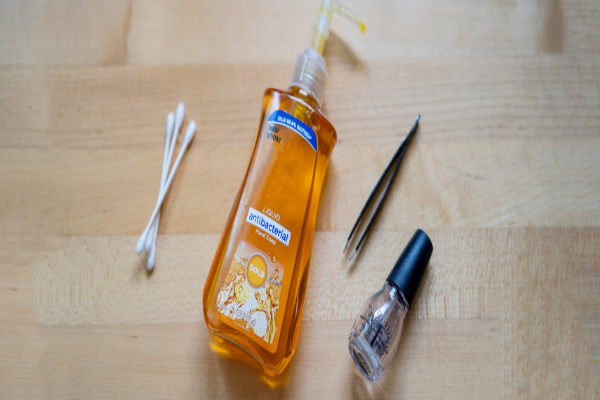
Mosquito Joe provides essential guidance on tick removal.
|
Between climate change and the expansion of human habitation, tick-borne diseases like Lyme are on the rise. Learning how to remove a tick safely is more important than ever. Did you know that if you botch the tick removal, part of the critter’s mouth parts will remain under your skin? (Gross – we know!). And that’s not the worst of it. Removing a tick the wrong way can actually increase the chance that you contract any disease it carries! Yet, simply following the proper procedure can ensure complete — and safe! — removal of the nasty blood-sucker.
Yep. Looks like we’re going to have to grasp the nitty-gritty of tick bites and how to remove a tick without making things worse. So, grab your fine-tipped tweezers and some isopropyl alcohol, and let’s get to work.
Tools You Need for Tick Removal
How to remove a tick is very different from dealing with any other insect on your body. While you can simply brush away most bugs, a tick attaches to your body, bites the skin, inserts a barbed feeding tube, and begins drinking your blood. Ticks also differ from most biting bugs in that they burrow into the skin and remain attached to the body for days up to a week! Blech! And if you just pinch and pull the nasty critter, it breaks in half, leaving its mouthparts embedded under your skin — increasing the risks of infection. This is why proper tick removal requires specific tools and the right technique.
Fortunately, the right tools for removing a tick are pretty basic. Here’s what you’ll need:
- Pointy tweezers – Choose tweezers with a pointed tip, not square. Your typical eyebrow tweezers likely aren’t pointy enough and might tear the tick’s body.
- Rubbing alcohol or soap and water – You will use this to clean the site thoroughly once the tick is removed.
- Disposable gloves – Ticks can carry many diseases. Disposable gloves prevent any transmission through even tiny breaks in your skin.
- Sealable baggie or container – This allows for safe disposal or identification and testing if needed.
- Magnifying glass – Helpful for spotting tiny ticks and for ensuring you remove the entire critter.
Keep these tick-removal tools handy in your home first-aid kit, and bring the kit along for any outdoor adventure in tick country, such as forests, woodlands, grasslands, fields, brushy areas, and urban or suburban parks.
Step-by-Step Guide to Removing a Tick
While you likely won’t feel a tick bite, the moment you spot a blood-sucking tick on your body, or worse — your child’s body — you’ll be anxious to remove the tick ASAP. Yes, prompt action is critical, but it’s even more important that you do the job right. Unsafe or inept tick removal methods can cause the tick to salivate and regurgitate into the bite site, which may increase the risk of disease transmission. So — take a deep breath, gather your tools, and proceed calmly.
This is how to remove a tick safely and minimize the risk of infection:
- Wash your hands, then put on your gloves.
- Clean the area surrounding the tick bite with rubbing alcohol or soap and water.
- Using your pointed tweezers, grasp the insect as closely as possible to its head. Do not squeeze the tick.
- Using slow, firm motions, apply steady pressure to pull the tick straight up and out of the skin — avoid jerking or twisting. If the tick breaks, make sure to go back to the bite site to remove the remaining head. If you are unable to remove all parts of the head, seek medical attention.
Now you know how to extract ticks and limit the damage caused by the bite. But remain alert to possible symptoms so you know if and when you should seek medical attention.
What to Do After Tick Removal
Learning how to remove a tick safely is just half the battle. Let’s see what to do with the tick and how to manage the wound after removing the tick.
After taking out a tick:
- Avoid handling it with your bare hands.
- Use the tweezers to place the tick’s body into the baggy or container from your tick removal kit.
- Add a tablespoon or so of isopropyl alcohol to submerge the tick, then seal the container. This both kills and preserves the tick for future medical testing if needed.
- Label the container with the date and general geographical location where the bite occurred.
- Use rubbing alcohol or soap and water to clean the bite area once again. Keep an eye on the bite site for the next few weeks.
Seek prompt medical attention following a tick removal if:
- You see signs of infection (redness, swelling, or pus) or experience symptoms of tick-borne diseases, such as a fever, rash, or fatigue,
- The tick was attached for more than 24 hours, or
- You were bitten in a hotspot for tick-borne diseases such as Lyme (Northeast and Midwest U.S.), Rocky Mounted spotted fever (Southeast U.S.), or babesiosis (Upper Midwest and Northeast).
Your physician may suggest having the tick tested.
Common Mistakes to Avoid During Tick Removal
As you can see, learning how to remove a tick safely isn’t that hard, but it is vital. As noted, removing a tick improperly can be even more damaging than leaving it to disengage on its own, because mistakes can increase your chance of contracting a tick-borne disease or infection.
Avoid these common tick removal mistakes:
- Applying heat to the tick’s body with a hot nail or match.
- Covering the tick with petroleum jelly, alcohol, nail polish, or gasoline.
- Killing the tick while it’s still attached to the skin.
- Crushing, squeezing, twisting, or puncturing the tick.
- Handling the tick body with bare hands.
Avoid the more dubious sites on the web and their, shall we say, “creative” recommendations for how to remove a tick. Instead, remain calm and follow the directions above to ensure safe removal. With this information, you’re ready to prepare for another severe tick season.
Proper Tick Removal: Your Key to Staying Healthy
You can never be too cautious about tick bites and preventing tick-borne illnesses. Now that you know how to remove a tick safely, you can take steps to enjoy outdoor fun free from these blood-sucking biters. Just remember that ticks aren’t found only in the wilds. Any wildlife that wanders through your yard may drop off a few hitchhiking ticks, ready to pounce on an unwary pet or person. That’s right — combatting ticks begins at home.
Reach out to your local Mosquito Joe® for effective tick control. It’s part of our comprehensive pest control services. We know you’ll love our service because we back everything we do with the Neighborly Done Right Promise™ and the Mosquito Joe Satisfaction Guarantee.
Request a free quote, and let’s get started. We’re making the outdoors fun again!
Tick Removal FAQs
How do ticks transmit disease?
Because ticks drink the blood of their hosts, either human or animal, they can pick up any disease their host is infected with. The tick then transmits the disease through its saliva. When the tick bites, a small amount of saliva enters the new host’s skin.
However, improper tick removal methods can stimulate the tick to salivate more heavily into the wound, increasing the transmission of pathogens. This is one reason it is essential to learn how to remove a tick safely.
Do tick bites itch or hurt?
Typically, tick bites do not itch or even hurt. You are unlikely to even feel a tick bite, so making regular checks for ticks is essential. If you find a tick on you, a family member, or a pet, be sure you know how to remove a tick safely so you can limit the potential transmission of disease and infection.
How to check for ticks?
It’s critical to check for ticks thoroughly after returning indoors. Spotting ticks early can help reduce the risk of disease. Once a tick attaches to the skin of its host, the potential for transmission of a tick-borne disease increases significantly after 24 hours. Therefore a visual examination of your body and lightly skimming with your hands across your skin, especially in places you cannot see, is critical to early tick detection.
A shower will wash off any crawling ticks. This is also a good time to search for ticks with your hands. Pay particular attention to underarms, behind ears and knees, under hair and on the scalp, inside the belly button, around the waist, and groin area. If you find an embedded tick on you or your pet, use the proper way to remove a tick and discard it safely.
What are tick bite symptoms?
Several different tick-borne diseases have similar symptoms, like fever, chills, aches, pains, and a rash. If you get bitten by a tick, be sure to remove the tick safely and, if possible, save the specimen for examination should you, a loved one, or a pet develop any symptoms. If you do develop symptoms within a few weeks, seek medical attention and submit the tick you removed for testing.
For reference, a Lyme disease rash has a characteristic bull’s eye appearance. The bite location will be red and slightly swollen, with the area around it clear and surrounded by a ring of reddened skin.
Contact Mosquito Joe for Tick Control Services Near You
You can never be too cautious about tick bites and preventing tick-borne illnesses. While it’s great to know how to remove a tick safely, it’s so much better to prevent tick bites! So, add an extra layer of protection to your outdoor fun with Mosquito Joe’s tick control treatments. We can help protect your family and property from ticks and a variety of biters, including mosquitoes, fleas, and gnats.
You know your tick control service will be done right and on time because Mosquito Joe is a Neighborly company. Our services are backed by the Neighborly Done Right Promise and the Mosquito Joe® Satisfaction Guarantee!
Contact Us
Secure your patio and property for bite-free fun! Just reach out to your local Mosquito Joe for barrier treatments to eliminate and prevent ticks.
Call us or contact us online to schedule professional tick control services.
This article is intended for general guidance only and may not be applicable to every situation. You are responsible for determining the proper course of action for your property and your situation. Mosquito Joe is not responsible for any damages that occur as a result of any advice or guidance derived from blog content. For the most accurate guidance, contact an independently owned and operated Mosquito Joe for more information and a professional on-site assessment.
